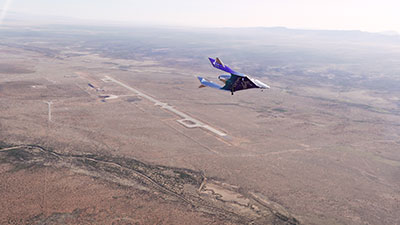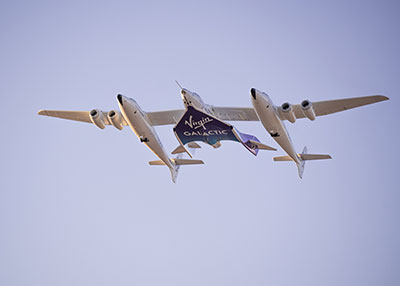 Space News space history and artifacts articles Messages space history discussion forums Sightings worldwide astronaut appearances Resources selected space history documents |
If you have previously registered, but forgotten your password, click here.
A primary reason for doing flight test on Eve is to inform our models. We have the ability to model our vehicle in terms of aerodynamics, loads and systems. Our engineers are able to use these computer models to predict how the vehicle will perform in different phases of flight. So, for flight tests, we actually go out and fly very specific conditions, gather data from the vehicle, such as airspeed, altitude, and various other aircraft parameters. Then the engineers look at the data and determine things like; to what degree did the wing bend or not bend? Our engineers take all of that information and update their models because, although we don't fly every possible situation, our computer models can and do! And we also conduct what's referred to as a "functional check flight". It's a standard practice in the aviation industry and is always a key step after maintenance or modifications are performed on the aircraft. We check everything on the ground and then again in flight, during different maneuvers at different altitudes and temperatures – especially extremely cold temps. Q: How do you get all that data from Eve? Is it like hooking her up to an EKG? It is something like that, yes! As an example, we use "strain gauges," which are devices that measure stresses and strains. We have a number of strain gauges, and we put them on specific areas of the wing, the landing gear, the tail surfaces, and along the fuselage. They measure different areas on the aircraft, and when we do a maneuver that should stress the aircraft, our engineers collect the data and go back and then update their model. So yeah, there's a number of different gauges throughout the vehicle. We also measure the stuff you would normally measure – attitude, airspeed, altitude. We have a data system that collects all of that information and puts it onto a drive. We can also send that information down to our control room so we have engineers that watch in real time as we're doing this, and they can see exactly what the aircraft is doing as we're flying. Q: Pilots say every plane has its own flying characteristics. After modification, will Eve fly differently? After we go through and re-rig our flight controls, it won't be exactly the same. We have specifications, of course, so we know the aircraft will fly properly, but it may not be exactly as it was before. Now, for the pilot, you may or may not notice it, but of course, that's why we get the data. The test pilot has an opinion, but the data has the facts! Regardless, I'm always impressed by how well Eve performs, especially when it doesn't have to carry a spaceship. For such a large aircraft, it's got a lot of get up a go! On take-off it practically leaps off the ground. And that's not even at full power! Now remember, it has two fuselages and that does take some getting used to because we're not sitting in the center of the airplane. Q: The biggest change to Eve is the launch pylon, the assembly in the center of the wing between the two fuselages, that cradles VSS Unity and releases it. It's the primary role Eve plays – to carry our spaceship to launch altitude. Is it possible to test the pylon without actually attaching Unity to it? Yes! One thing we will do is take it out – without any spaceship attached to it – up to high altitude, cold-soak it (make sure everything operates in extremely cold temperature), then we actuate the hooks that would normally attach to the spaceship and collect data on how they performed. Q: After Eve passes its flight test, when will it head back to Spaceport? And is VSS Unity ready to go for a ride? Yep, Unity is ready and waiting! After we complete system checks during initial flight test, Eve will fly what we call a ferry flight to New Mexico. The team is excited to see Eve and Unity reunited again, and we have some more testing to do with the mothership and spaceship combined – including more ground testing, glide and powered flight to complete the required validations of the vehicle's modifications. | ||||||||
| Robert Pearlman | Virgin Galactic release Virgin Galactic Completes Glide Flight From Spaceport America | |||||||


